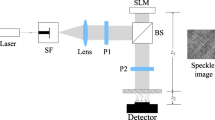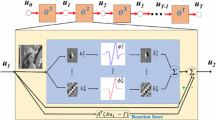Abstract
Speckle removal aims to smooth noise while preserving image boundaries and texture information. In recent years, speckle removal models based on deep learning methods have attracted a lot of attention. However, it was found that these models are less robust to adversarial attacks. The adversarial attack makes the image recovery of deep learning methods significantly less effective when the speckle noise distribution is almost unchanged. In purpose of addressing the above problem, we propose a diffusion equation-based speckle removal model that can improve the robustness of deep learning algorithms in this paper. The model utilizes a deep learning image prior and an image grayscale detection operator together to construct the coefficient function of the diffusion equation. Among them, there is a high possibility that the deep learning image prior is inaccurate or even incorrect, but it will not affect the performance and the properties of the proposed diffusion equation model for noise removal. Moreover, we analyze the robustness of the proposed diffusion equation model in terms of theoretical and numerical properties. Experiments show that our proposed diffusion equation speckle removal model is not affected by adversarial attacks in any way and has stronger robustness.











Similar content being viewed by others
References
Aubert, G., Aujol, J.F.: A variational approach to removing multiplicative noise. SIAM J. Appl. Math. 68(4), 925–946 (2008)
Busse, L., Crimmins, T., Fienup, J.: A model based approach to improve the performance of the geometric filtering speckle reduction algorithm. In: 1995 IEEE Ultrasonics Symposium. Proceedings. An International Symposium, vol. 2, pp. 1353–1356 (1995). https://doi.org/10.1109/ULTSYM.1995.495807
Carlini, N., Wagner, D.: Towards evaluating the robustness of neural networks. In: 2017 IEEE Symposium on Security and Privacy (sp), pp. 39–57. IEEE (2017)
Catté, F., Lions, P.L., Morel, J.M., Coll, T.: Image selective smoothing and edge detection by nonlinear diffusion. SIAM J. Numer. Anal. 29(1), 182–193 (1992). https://doi.org/10.1137/0729012
Chen, Y., Pock, T.: Trainable nonlinear reaction diffusion: a flexible framework for fast and effective image restoration. IEEE Trans. Pattern Anal. Mach. Intell. 39(6), 1256–1272 (2016). https://doi.org/10.1109/TPAMI.2016.2596743
Cheng, L., Guo, Z., Li, Y., **ng, Y.: Two-stream multiplicative heavy-tail noise despeckling network with truncation loss. IEEE Trans. Geosci. Remote Sens. 61, 1–17 (2023). https://doi.org/10.1109/TGRS.2023.3302953
Chierchia, G., Cozzolino, D., Poggi, G., Verdoliva, L.: Sar image despeckling through convolutional neural networks. In: 2017 IEEE International Geoscience and Remote Sensing Symposium (IGARSS), pp. 5438–5441. IEEE (2017)
Dalsasso, E., Denis, L., Tupin, F.: SAR2SAR: a semi-supervised despeckling algorithm for SAR images. IEEE J. Sel. Top. Appl. Earth Obs. Remote Sens. 14, 4321–4329 (2021). https://doi.org/10.1109/JSTARS.2021.3071864
Deledalle, C.A., Denis, L., Tabti, S., Tupin, F.: MuLoG, or how to apply gaussian denoisers to multi-channel SAR speckle reduction? IEEE Trans. Image Process. 26(9), 4389–4403 (2017). https://doi.org/10.1109/TIP.2017.2713946
Deledalle, C.A., Denis, L., Tupin, F.: Iterative weighted maximum likelihood denoising with probabilistic patch-based weights. IEEE Trans. Image Process. 18(12), 2661–2672 (2009). https://doi.org/10.1109/TIP.2009.2029593
Di Martino, G., Poderico, M., Poggi, G., Riccio, D., Verdoliva, L.: Benchmarking framework for SAR despeckling. IEEE Trans. Geosci. Remote Sens. 52(3), 1596–1615 (2014). https://doi.org/10.1109/TGRS.2013.2252907
Dong, Y., Zeng, T.: A convex variational model for restoring blurred images with multiplicative noise. SIAM J. Imag. Sci. 6(3), 1598–1625 (2013)
Evans, L.C.: Weak convergence methods for nonlinear partial differential equations, vol. 74. American Mathematical Soc. (1990)
Evans, L.C.: Partial differential equations, vol. 19. American Mathematical Society (2022)
Foucart, S., Rauhut, H.: An invitation to compressive sensing. In: A mathematical Introduction to Compressive Sensing, pp. 1–39. Springer (2013)
Gan, Y., Zhang, J., Chang, H.: New splitting algorithms for multiplicative noise removal based on Aubert-Aujol model. Numer. Math. Theory Methods Appl. (2022). https://doi.org/10.4208/nmtma.OA-2021-0134
Goodfellow, I.J., Shlens, J., Szegedy, C.: Explaining and harnessing adversarial examples. ar**v preprint ar**v:1412.6572 (2014)
Goodman, J.W.: Some fundamental properties of speckle. JOSA 66(11), 1145–1150 (1976)
**, Z., Yang, X.: Analysis of a new variational model for multiplicative noise removal. J. Math. Anal. Appl. 362(2), 415–426 (2010)
Ko, J., Lee, S.: SAR image despeckling using continuous attention module. IEEE J. Sel. Top. Appl. Earth Obs. Remote Sens. 15, 3–19 (2022). https://doi.org/10.1109/JSTARS.2021.3132027
Kuan, D.T., Sawchuk, A.A., Strand, T.C., Chavel, P.: Adaptive noise smoothing filter for images with signal-dependent noise. IEEE Trans. Pattern Anal. Mach. Intell. 2, 165–177 (1985). https://doi.org/10.1109/TPAMI.1985.4767641
Kurakin, A., Goodfellow, I.J., Bengio, S.: Adversarial examples in the physical world. In: Artificial Intelligence Safety and Security, pp. 99–112. Chapman and Hall/CRC (2018)
Ladyzhenskaia, O.A., Solonnikov, V.A., Ural’tseva, N.N.: Linear and quasi-linear equations of parabolic type, vol. 23. American Mathematical Soc. (1988)
Lee, J.S.: Digital image enhancement and noise filtering by use of local statistics. IEEE Trans. Pattern Anal. Mach. Intell. 2, 165–168 (1980). https://doi.org/10.1109/TPAMI.1980.4766994
Lions, J.L.: Optimal Control of Systems Governed by Partial Differential Equations, vol. 170, pp. 100–108, Springer, Berlin (1971).
Lopes, A., Nezry, E., Touzi, R., Laur, H.: Maximum a posteriori speckle filtering and first order texture models in sar images. In: 10th Annual International Symposium on Geoscience and Remote Sensing, pp. 2409–2412 (1990). https://doi.org/10.1109/IGARSS.1990.689026
Lv, Y.: Total generalized variation denoising of speckled images using a primal-dual algorithm. J. Appl. Math. Comput. 62(1–2), 489–509 (2020)
Ma, X., Wang, C., Yin, Z., Wu, P.: Sar image despeckling by noisy reference-based deep learning method. IEEE Trans. Geosci. Remote Sens. 58(12), 8807–8818 (2020). https://doi.org/10.1109/TGRS.2020.2990978
Madry, A., Makelov, A., Schmidt, L., Tsipras, D., Vladu, A.: Towards deep learning models resistant to adversarial attacks. ar**v preprint ar**v:1706.06083 (2017)
Majee, S., Ray, R.K., Majee, A.K.: A new non-linear hyperbolic-parabolic coupled PDE model for image despeckling. IEEE Trans. Image Process. 31, 1963–1977 (2022). https://doi.org/10.1109/TIP.2022.3149230
Mittal, A., Moorthy, A.K., Bovik, A.C.: No-reference image quality assessment in the spatial domain. IEEE Trans. Image Process. 21(12), 4695–4708 (2012)
Moosavi-Dezfooli, S.M., Fawzi, A., Frossard, P.: Deepfool: a simple and accurate method to fool deep neural networks. In: Proceedings of the IEEE Conference on Computer Vision and Pattern Recognition, pp. 2574–2582 (2016)
Perona, P., Malik, J.: Scale-space and edge detection using anisotropic diffusion. IEEE Trans. Pattern Anal. Mach. Intell. 12(7), 629–639 (1990). https://doi.org/10.1109/34.56205
Ramos-Llordén, G., Vegas-Sánchez-Ferrero, G., Martin-Fernandez, M., Alberola-López, C., Aja-Fernández, S.: Anisotropic diffusion filter with memory based on speckle statistics for ultrasound images. IEEE Trans. Image Process. 24(1), 345–358 (2014)
Rudin, L., Lions, P.L., Osher, S.: Multiplicative Denoising and Deblurring: Theory and Algorithms, pp. 103–119. Springer, New York (2003). https://doi.org/10.1007/0-387-21810-6_6
Shan, X., Sun, J., Guo, Z.: Multiplicative noise removal based on the smooth diffusion equation. J. Math. Imaging Vis. 61, 763–779 (2019)
Shan, X., Sun, J., Guo, Z., Yao, W., Zhou, Z.: Fractional-order diffusion model for multiplicative noise removal in texture-rich images and its fast explicit diffusion solving. BIT Numer. Math. (2022). https://doi.org/10.1007/s10543-022-00913-3
Shen, H., Zhou, C., Li, J., Yuan, Q.: Sar image despeckling employing a recursive deep CNN prior. IEEE Trans. Geosci. Remote Sens. 59(1), 273–286 (2021). https://doi.org/10.1109/TGRS.2020.2993319
Shi, J., Osher, S.: A nonlinear inverse scale space method for a convex multiplicative noise model. SIAM J. Imaging Sci. 1(3), 294–321 (2008). https://doi.org/10.1137/070689954
Simon, J.: Compact sets in the space l p (o, t; b). Ann. Mat. 146, 65–96 (1986)
Su, D., Zhang, H., Chen, H., Yi, J., Chen, P.Y., Gao, Y.: Is robustness the cost of accuracy?–a comprehensive study on the robustness of 18 deep image classification models. In: Proceedings of the European Conference on Computer Vision (ECCV), pp. 631–648 (2018)
Szegedy, C., Zaremba, W., Sutskever, I., Bruna, J., Erhan, D., Goodfellow, I., Fergus, R.: Intriguing properties of neural networks. In: 2nd International Conference on Learning Representations, ICLR 2014 (2014)
Tur, M., Chin, K.C., Goodman, J.W.: When is speckle noise multiplicative? Appl. Opt. 21(7), 1157–1159 (1982)
Vitale, S., Ferraioli, G., Pascazio, V.: Multi-objective CNN-based algorithm for SAR despeckling. IEEE Trans. Geosci. Remote Sens. 59(11), 9336–9349 (2021). https://doi.org/10.1109/TGRS.2020.3034852
Weickert, J., Romeny, B., Viergever, M.: Efficient and reliable schemes for nonlinear diffusion filtering. IEEE Trans. Image Process. 7(3), 398–410 (1998). https://doi.org/10.1109/83.661190
Xu, B., Cui, Y., Li, Z., Zuo, B., Yang, J., Song, J.: Patch ordering-based SAR image despeckling via transform-domain filtering. IEEE J. Sel. Top. Appl. Earth Obs. Remote Sens. 8(4), 1682–1695 (2015). https://doi.org/10.1109/JSTARS.2014.2375359
Yan, H., Zhang, J., Feng, J., Sugiyama, M., Tan, V.Y.: Towards adversarially robust deep image denoising. ar**v preprint ar**v:2201.04397 (2022)
Yao, W., Guo, Z., Sun, J., Wu, B., Gao, H.: Multiplicative noise removal for texture images based on adaptive anisotropic fractional diffusion equations. SIAM J. Imaging Sci. 12(2), 839–873 (2019)
Yu, Y., Acton, S.T.: Speckle reducing anisotropic diffusion. IEEE Trans. Image Process. 11(11), 1260–1270 (2002)
Zhang, Q., Yuan, Q., Li, J., Yang, Z., Ma, X.: Learning a dilated residual network for SAR image despeckling. Remote Sens. 10(2), 55 (2018). https://doi.org/10.3390/rs10020196
Zhou, Z., Guo, Z., Dong, G., Sun, J., Zhang, D., Wu, B.: A doubly degenerate diffusion model based on the gray level indicator for multiplicative noise removal. IEEE Trans. Image Process. 24(1), 249–260 (2014)
Zhou, W., Bovik, A.C., Sheikh, H.R., Simoncelli, E.P.: Image quality assessment: from error visibility to structural similarity. IEEE Trans. Image Process. 13(4), 600–612 (2004)
Author information
Authors and Affiliations
Contributions
L.C. performed theorem derivations, experiments, and manuscript writing. Y.X. performed the review of the manuscript. Y.L guided neural network adversarial attacks. Z.G. involved in method illustration and manuscript review.
Corresponding author
Ethics declarations
Conflict of interest
The authors declare that they have no conflict of interest.
Additional information
Publisher's Note
Springer Nature remains neutral with regard to jurisdictional claims in published maps and institutional affiliations.
Rights and permissions
Springer Nature or its licensor (e.g. a society or other partner) holds exclusive rights to this article under a publishing agreement with the author(s) or other rightsholder(s); author self-archiving of the accepted manuscript version of this article is solely governed by the terms of such publishing agreement and applicable law.
About this article
Cite this article
Cheng, L., **ng, Y., Li, Y. et al. A Diffusion Equation for Improving the Robustness of Deep Learning Speckle Removal Model. J Math Imaging Vis (2024). https://doi.org/10.1007/s10851-024-01199-6
Received:
Accepted:
Published:
DOI: https://doi.org/10.1007/s10851-024-01199-6




